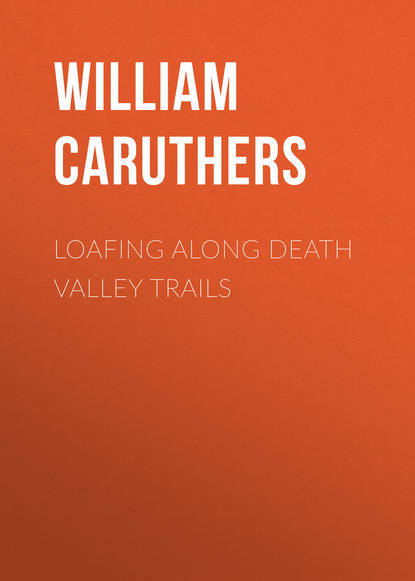По всем вопросам обращайтесь на: info@litportal.ru
(©) 2003-2024.
✖
Loafing Along Death Valley Trails
Настройки чтения
Размер шрифта
Высота строк
Поля
A spot somewhat distant from the regular cemetery was chosen for the burial place and it became known as Jim Bruce’s private graveyard.
Remi Nadeau, a French Canadian, was the first to haul freight into Panamint City. Nadeau was a genius of transportation. There was no country too rough, too remote, too wild for him. He came to Los Angeles in 1861 from Utah and teamed as far east as Montana.
The Cerro Gordo mine, on the eastern side of Owens Lake in Inyo County began to ship ore in 1869 and Nadeau obtained a contract to haul the ore to Wilmington where it was shipped by boat to San Francisco. He soon had to increase his equipment to 32 teams, using more than 500 animals. For his return trip he bought such commodities as he could peddle or leave for sale at stations he built along the route.
In 1872, the contract having expired, Judson and Belshaw, owners of the mine, received a lower bid and Nadeau was left with 500 horses on his hands and heavily in debt. He wanted to dispose of his outfit for the benefit of his creditors but they had confidence in him and persuaded him to “carry on.” Borax discovered in Nevada saved him. Meanwhile the lower bidder on the Cerro Gordo job proved unsatisfactory and Judson and Belshaw asked Nadeau to take the old job back. But now Nadeau informed them they would have to buy a half interest in his outfit and advance $150,000 to construct relay stations at Mud Springs, Mojave, Lang’s Springs, Red Rock, Little Lake, Cartago, and other points. They gladly agreed.
Shortly after Nadeau began hauling across the desert, he picked up a man suffering from gunshot and crazed from thirst. Taking the victim to his nearest station, he left instructions that he be cared for.
Sometime afterward, one of Nadeau’s competitors whose trains had been held up several times by outlaws, wondered why none of Nadeau’s teams or stations had been molested. At the time, Nadeau himself didn’t know that the fellow whom he’d picked up on the desert was Tiburcio Vasquez, the bandit terror.
Vasquez naively condoned his banditry. It disgusted him at dances he said, to see the senoritas of his race favor the interloping Americans. He had a singular power over women. When Sheriff William Rowland effected his capture, women of Los Angeles filled his cell with flowers. He was hanged at San Jose.
Nadeau was now hauling ore from the Minnietta and the Modoc mines in the Argus Range on the west side of Panamint Valley. The Modoc was the property of George Hearst, the father of the publisher, William Randolph Hearst. These mines were directly across the valley from Panamint City and because of Nadeau’s record for building roads in places no other dared to go, Jones and Stewart engaged him to haul out of Surprise Canyon, which was barely wide enough in places for a burro with a pack.
On a hill, locally known as “Seventeen” – that being the per cent of grade, located on the old highway between Ballarat and Trona, one may see the dim outline of a road pitching down precipitously to the valley floor. This road was built by Nadeau and one marvels that anything short of steam power could move a load from bottom to top.
Acquiring a fortune, Nadeau built the first three-story building in Los Angeles and the Nadeau Hotel, long the city’s finest, retained favor among many wealthy pioneer patrons long after the more glamorous Angelus and Alexandria were built in the early 1900’s.
The first ore from the Panamint mines was shipped to England and because of its richness showed a profit, but difficulties arose in recovery processes which they did not know how to overcome. The mines would have paid fabulously under present day processes.
Finis was written to the story of Panamint after two hectic years and in 1877 Jones and Stewart had lost $2,000,000 and quit. It would be more factual to state that since they had received from the public $2,000,000 to put into it, who lost what is a guess.
Chapter XXIV
Indian George. Legend of the Panamint
The previous chapter records accepted history of the silver discovery at Panamint City. Indian George Hansen had another version which he told me at his ranch 11 miles north of Ballarat. It fits the period and the people then in the country.
George, when a youngster lived in the Coso Range. East of the Coso there was no white man for 100 miles and renegades fleeing from their crimes and deserters from the Union army sought hideouts in the Panamint. Thus George was employed as a guide by three outlaws to lead them to safe refuge.
George, a Shoshone, had both friends and relatives among the Shoshones and the Piutes and took the bandits into Surprise Canyon where a camp for the night was chosen. While staking out his pack animals, George discovered a ledge of silver ore. Breaking off a chunk, he stuck it into his pocket, saying nothing about it until they were out of the locality. Then he showed the specimen and to promote a deal, gave one of them a sample. They wanted to see the ledge but George refused to disclose it. Then George said the three fellows stepped aside and after talking in whispers told him they didn’t like the country and returning with him to the Coso Range, went on their way. Two or three months later they were back to bargain.
George had traded with the white man before. They had always given him a few dollars and a rosy promise. “Now me pretty foxy. So I say, ‘no want money. Maybe lose.’ Him say, ‘what hell you want?’
“‘Heap good job all time I live.’
“‘Okay,’ him say. ‘We give you job.’
“I show claim.” George paused, a look of smoldering hate in his dark eyes, then added: “I get job. Two weeks. Him say, ‘you fired.’ I get $50.”
All Indians and many of the old timers believe that the ledge George found was that for which Jones and Stewart paid $2,000,000.
George made another deal worthy of mention. The town of Trona on Searles’ Lake needed the water owned by George’s relative, Mabel, who herded 500 goats and sold them to butchers at Skidoo, Goldfield, and Rhyolite where they became veal steak or lamb chops. Trona offered $30 a month for the use of the water. Mabel consulted George as head man of the Shoshones and advised Trona that the sum would not be considered. It must pay $27.50 or do without. A superstition regarding numbers accounted for the price George fixed for the water.
My acquaintance with Indian George began on my first trip to Ballarat with Shorty Harris and was the result of a stomach ache Shorty had. I suggested a trip to a doctor at Trona instead.
“No, sir. I’ll see old Indian George. If these doctors knew as much as these old Indians, there wouldn’t be any cemeteries.”
I asked what evidence he had of George’s skill.
“Plenty. You know Sparkplug (Michael Sherlock)? He was in a bad way. Fred Gray put a mattress in his pickup, laid Sparkplug on it and hauled him over to Trona. Nurses took him inside. Doctor looked him over and came out and asked Fred if he knew where old Sparkplug wanted to be buried. ‘Why, Ballarat, I reckon,’ Fred said.
“Well, you take him back quick. He’ll be dead when you get there. Better hurry. He’ll spoil on you this hot weather.’
“Fred raced back, taking curves on Seventeen with two wheels hanging over the gorge, but he made it; stopped in front of Sparkplug’s shack, jumped out and called to me to bring a pick and shovel. Then he ran over to Bob Warnack’s shack for help to make a coffin. Indian George happened to ride by the pickup and saw Sparkplug’s feet sticking out. He crawled off his cayuse, took a look, lifted Sparkplug’s eyelids and leaving his horse ground-hitched, he went out in the brush and yanked up some roots here and there. Then he went up to Hungry Hattie’s and came back with a handful of chicken guts and rabbit pellets; brewed ’em in a tomato can and when he got through he funneled it down Sparkplug’s throat and in no time at all Sparkplug was up and packing his flivver to go prospecting. If you don’t believe me, there’s Sparkplug right over there tinkering with his car.”
George’s age has been a favorite topic of writers of Death Valley history for the last 30 years.
I stopped for water once at the little stream flumed out of Hall’s Canyon to supply the ranch. He was irrigating his alfalfa in a temperature of 122 degrees. I had brought him three or four dozen oranges and suggested that Mabel would like some of the fruit.
“Heavy work for a man of your age,” I said.
He bit into an orange, eating both peeling and pulp. “Me papoose. Me only 107 years old.”
There were less than a dozen oranges left when I began to cast about for a tactful way to preserve a few for Mabel. Seeing her chopping wood in the scorching sun I said, “I’ll bet Mabel would like an orange just now. Shall I call her?”
“No – no – ” George grunted. “Oranges heap bad for squaw,” and speeding up his eating, he removed the last menace to Mabel.
Once George told me of watching the sufferings of the Jayhawkers and Bennett-Arcane party:
“Me little boy, first time I see white man. Whiskers make me think him devil. I run. I see some of Bennett party die. When all dead, we go down. First time Indians ever see flour. Squaws think it what make white men white and put it on their faces.”
I asked George why he didn’t go down and aid the whites. “Why?” he asked, “to get shot?”
“How many Shoshones are left?” I asked George.
He counted them on his fingers. “Nineteen. Soon, none.”
George died in 1944 and it is safe I believe, to say that for 110 years he had baffled every agency of death on America’s worst desert. Because his ranch was a landmark and the water that came from the mountains was good, it was a natural stopping place and he was known to thousands. Following a curious custom of Indians George adopted the Swedish name Hansen because it had euphony he liked.
The Panamint is the locale of the legend of Swamper Ike, first told I believe by Old Ranger over a nation-wide hookup, while he was M.C. of the program “Death Valley Days.”
A daring, but foolhardy youngster, with wife and baby, undertook to cross the range. Unacquainted with the country and scornful of its perils, he reached the crest, but there ran out of water. He left his wife and the baby on the trail, comfortably protected in the shade of a bluff and started down the Death Valley side of the range to find water.
After a thorough search of the canyons about, he climbed to a higher level, scanned the floor of the valley. Seeing a lake that reflected the peaks of the Funeral Range he made for it under a withering sun. He learned too late that it was a mirage and exhausted, started back only to be beaten down and die.
After waiting through a night of terror, the young mother prepared a comfortable place for her baby and went in search of her husband. She too saw the blue lake and made for it, saw it vanish as he had. Then she discovered his tracks and undertook to follow him, but she also was beaten down and fell dead within a few feet of his lifeless body.
A band of wandering Cocopah Indians crossing the range, found the baby. They took the child to their own habitation on the Colorado river and named him Joe Salsuepuedes, which is Indian for “Get-out-if-you-can.”
Joe grew up as Indian, burned dark by the desert sun. But he had an idea he wasn’t Indian. Learning that he was a foundling, picked up in the Panamint, he set out for Death Valley, possessed of a singular faith that somehow he would discover evidence that he was a white man.
He obtained a job as swamper for the Borax Company. When he gave his name the boss said, “Too many Joe’s working here. We’ll call you Ike.”
Early Indians, as you may see in Dead Man’s Canyon, the Valley of Fire, and numerous canyons in the western desert had a habit of scratching stories of adventure or signs to inform other Indians of unusual features of a locality on the canyon walls – often coloring the tracing with dyes from herbs or roots. Knowing this, Swamper Ike was always alert for these hieroglyphs on any boulder he passed or in any canyon he entered.
One day Swamper Ike went out to look for a piece of onyx that he could polish and give to the girl he loved. While seeking the onyx he noticed a flat slab of travertine and on it the picture story of “Get-out-if-you-can.”







